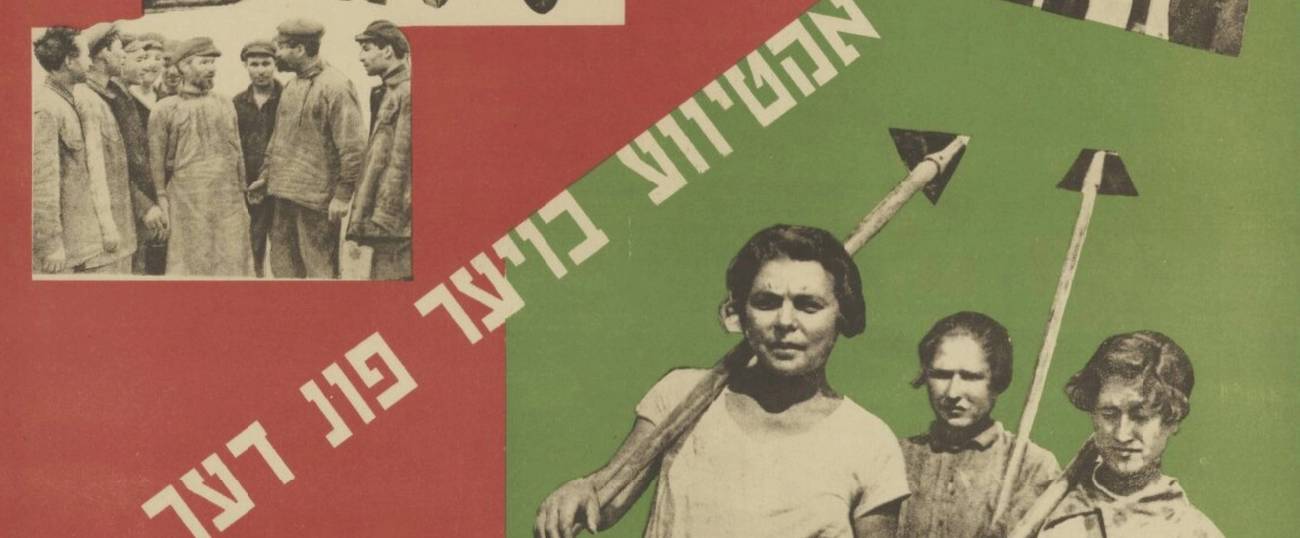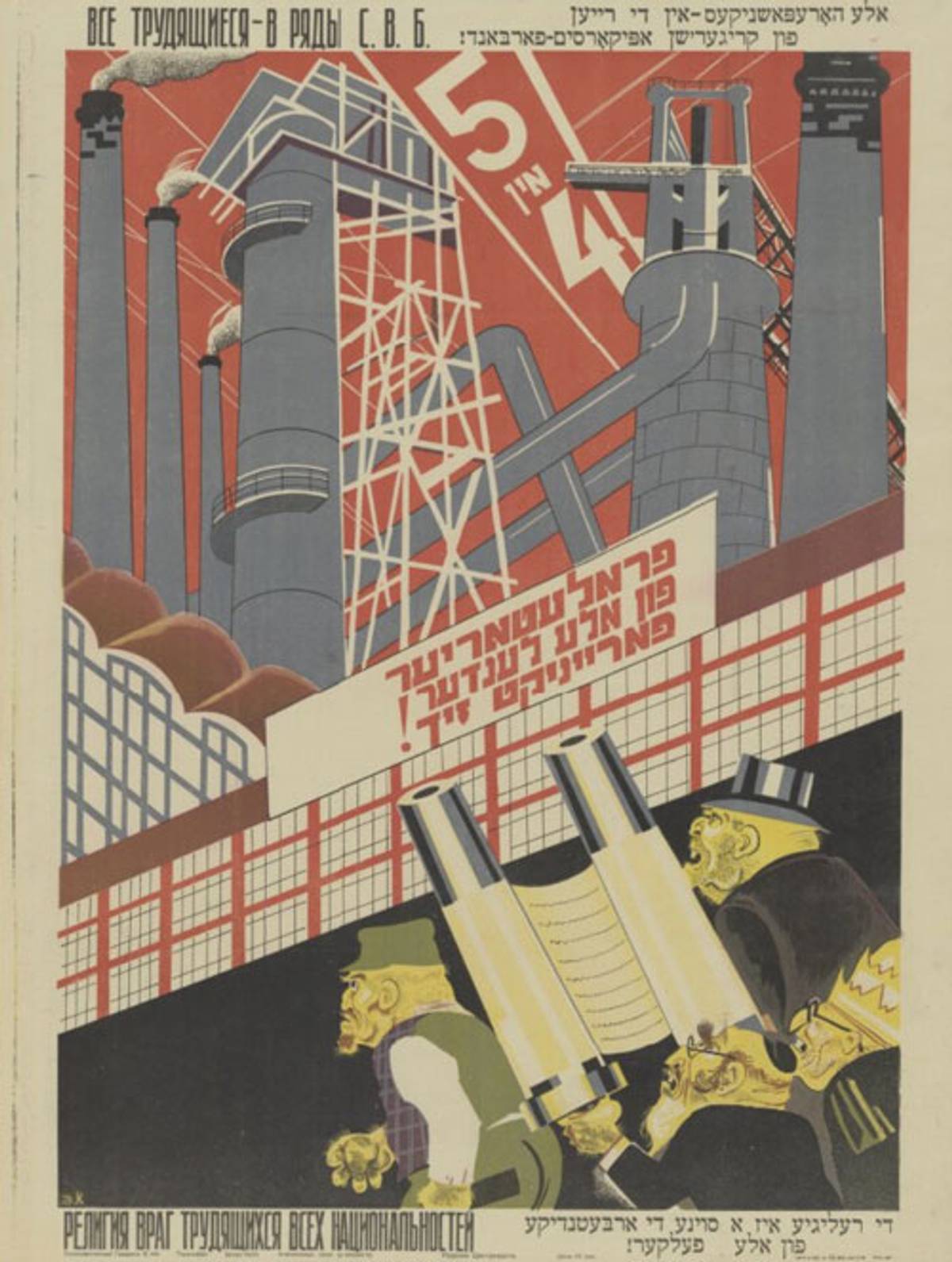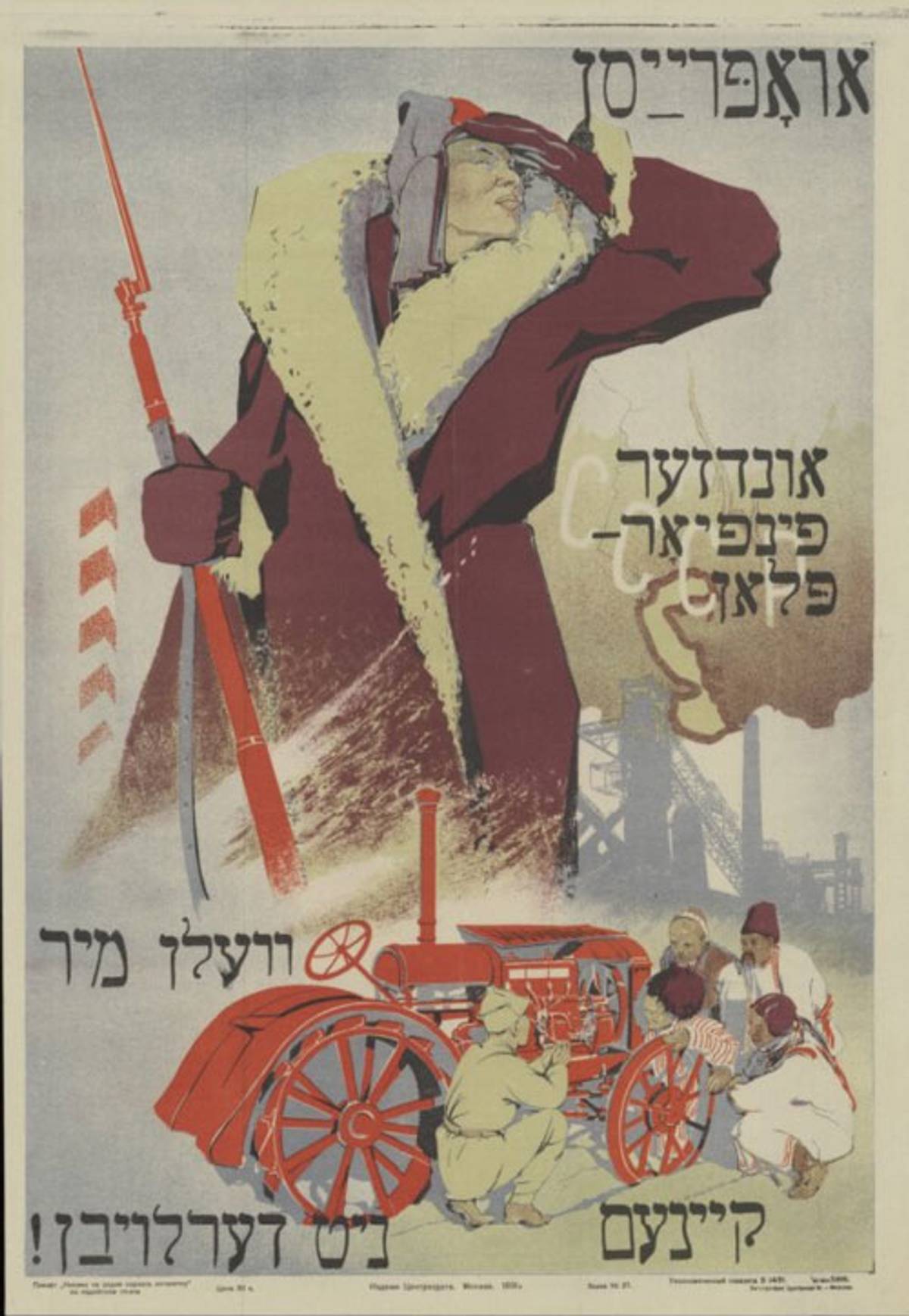The Cool Kids
Self-mutilation as a Jewish cultural strategy and the sad history of the Yevsektsiya



The teenage boys who played competitive athletics in the gymnasium in Jerusalem 2,100 years ago had their circumcisions reversed, because otherwise they wouldn’t have been allowed to play. In the Hellenistic empire that conquered Judea, sports were sacred, the entry point to being a person who mattered, the ultimate height of cool—and sports, of course, were always played in the nude. As one can imagine, ancient genital surgery of this nature was excruciating and potentially fatal. But the boys did not want to miss out.
I learned this fun fact in seventh grade, from a Hebrew-school teacher who was instructing me and my pubescent classmates about the Hanukkah story—about how Hellenistic tyranny gained a foothold in ancient Judea with the help of Jews who went along for the ride. This teacher seemed overly jazzed to talk about penises with a bunch of adolescents, and I suspected he’d made the whole thing up. At home I pulled a dusty old book off my parents’ shelf, Volume 1 of Heinrich Graetz’s History of the Jews. There I discovered that it was true, and also far worse.
In 19th-century academic prose, Gratz noted the “painful operation” boys underwent “to disguise the fact that they were Judeans.” But then he briskly moved on to an “unscrupulous” Jewish man named Menelaus, whose story was even more perverse. Menelaus, a local power player eager to ingratiate himself with the new regime, offered the tyrant Antiochus 300 talents of gold in exchange for appointing him as the high priest in the Jerusalem Temple. Antiochus agreed, which left Menelaus with the slight problem that he did not actually have 300 talents of gold. Menelaus solved this problem by stealing the Temple’s sacred golden vessels and using them as payment. When his fellow Jews rose up against him in outrage, Menelaus told Antiochus that these Jews were actually working for Antiochus’ Egyptian enemies.
Bad enough, but Menelaus went further. According to Gratz, Menelaus not only falsely accused the Jews of treason in order to protect himself, but also “maligned Judaism; he said that the Law of Moses was replete with hatred of humanity, for it forbade the Jews to take part in the repasts of other nations, or to show any kindness to strangers.” Antiochus responded to the threat by bringing his army to Jerusalem, taking over the Temple, and massacring the Jews. Sometime after that, the Maccabees showed up. That’s the part of the story we usually hear.

The stupid joke about why we celebrate Jewish holidays (“they tried to kill us, they failed, let’s eat”) hides an enormous difference between two of those holidays, which illustrate very different versions of anti-Semitism: Purim and Hanukkah. The distinction could not be more relevant today, as Jews around the world face a rising tide of anti-Semitism whose dynamics are sometimes straightforward and sometimes utterly baffling. As I struggle to understand the weirdness, I find myself returning to dusty old books.
The Purim story from ancient Persia fits well into seventh-grade notions of “prejudice”: Bad guy notices that Jews are different and therefore contaminating the blood-and-soil, so he decides to get rid of them. It resembles what we now consider right-wing anti-Semitism—and it’s the kind that American Jews, descended as many of us are from survivors of Russian Empire pogroms or the Holocaust, have been taught to recognize.
Hanukkah anti-Semitism, which can rear its head on either the right or the left, is something quite different. It doesn’t demand dead or expelled Jews, at least not at first. Instead it demands the destruction of Jewish civilization. This process requires not dead Jews, but Jews who are willing to give up whatever specific aspect of Jewish civilization is deemed to be uncool.
Of course, Judaism has always been uncool, going back to its origins as the planet’s only monotheism, featuring a bossy and unsexy invisible God. Uncoolness is pretty much Judaism’s brand, which is why cool people find it so threatening—and why Jews who are willing to become cool are absolutely necessary to Hanukkah-style anti-Semitism’s success. In the days of Antiochus, this type of anti-Semitism needed those boys who voluntarily underwent painful genital surgery to prove that Jews weren’t the problem—just the barbarity of Jewish law. During the Soviet era, it needed proud internationalists to prove that Jews weren’t the problem, just the repulsive chauvinism of Jewish national identity—including what we now call Zionism.
The Soviets actually went one better. In 1918, they created an entire branch of their government solely for cool Jews, whose paid job was to persecute the uncool ones. This was called the Yevsektsiya, or the Jewish Sections of the Communist Party, and in their brief and bloody lifespan, one finds the origins of today’s supposedly novel concept: Jews who are of course not anti-Semitic (how could they be? they’re Jews!), but simply anti-Zionist. In the course of not being anti-Semitic and being simply anti-Zionist, the Yevsektsiya managed to persecute, imprison, torture, and murder thousands of Jews, until their leaders were themselves purged.
Yevsektsiya-style anti-Semitism, or Hannukah-style anti-Semitism, always promises Jews a kind of nobility, offering them the opportunity to cleanse themselves of whatever the people around them happen to find revolting. The Jewish traits designated as repulsive vary by country and time period, but they invariably contradict the specific values that the surrounding culture has embraced as “universal.”
The reason for this is clear: There is actually nothing “universal” about those particular values, except the insecurity of the societies hoping to enforce them. Not everyone feels it is critical to a well-lived life to play sports in the nude; not everyone believes that Jesus is the son of God; not everyone agrees that authoritarian central planning is the solution to the world’s ills; not everyone thinks that denouncing one’s ties to an ancestral homeland is a sign of virtue. Jewish particularity exposes the arrogance of a society’s self-righteous leaders along with their profound insecurity, their deep fear of any suggestion that there are other ways to be. Those insecure leaders then enlist the help of Jews by promising them a merit badge of universal righteousness. Thanks to Judaism’s inherent uncoolness, there will never be a shortage of Jews willing to comply.
As a Yiddish literature scholar, I had encountered the Yevsektsiya as a glum footnote in my studies. But I discovered its details only recently in a fashion similar to my seventh-grade discovery of Menelaus, through a dusty old book—a 1972 volume by the historian Zvi Gitelman, with the ostentatiously boring title Jewish Nationality and Soviet Politics: The Jewish Sections of the CPSU, 1917-1930. It was a history of the Yevsektsiya, and the story it reported in arid academic prose could not have been more bizarre.
The ostensible purpose of the Yevsektsiya was to spread Communist ideology to Russia’s Jewish masses, among whom there were few Bolsheviks in 1917. Russia’s Jewish revolutionaries had mainly been Bundists (socialists), Mensheviks or Trotskyists, who failed to back the winner, Lenin. As for the vaunted Jewish “masses,” most were Yiddish-speakers from small towns, many of which were devastated during World War I. Such people were a suitably desperate proletariat, but the Communist Party needed Yiddish-speaking insiders to help them see the light.

At first, there were so few Jews among the Bolsheviks that the party had to rely on two Norwegian Jews with dictionaries to create Yiddish-language propaganda. But after the Russian Civil War in 1918-1920 left upwards of 70% of Jews without any regular income, and after the pogroms of that period left upwards of 50,000 Jews dead, Bolshevism at least offered steady government jobs.
Some Jews who joined the Bolsheviks were genuine idealists. Some, after the extreme anti-Semitic violence of the Civil War, may have unconsciously followed the classic strategy of “court Jews,” cultivating ties to the regime as a way of protecting the community—and themselves. And some, aware of the community’s late arrival to Bolshevism, may have wanted to prove that they were even better Communists than everyone else. In any case, as Gitelman’s book put it, “The Jewish sections [Yevsektsiya] betook themselves to the task of destroying the old order with a zest that cannot be explained by enthusiasm for Bolshevism alone.”
Destroy it they did. The Yevsektsiya first eliminated the kehillas, or traditional Jewish community organizations in Russia’s towns and cities, by legally abolishing them. When that didn’t work, they burned kehilla offices down. Russian Jews at the time could be forgiven for thinking that this zeal was simply part of the new order’s intolerance for religion; after all, churches and mosques were often targeted, too.
But by 1919, the Yevsektsiya resolved at their annual conference that shutting down traditional Jewish institutions was insufficient. Their mission now was to destroy all Zionist activity—a category that extended from political organizations to sports clubs. Nor did the Yevsektsiya drag their feet. Within a few weeks of the conference, they had successfully raided the offices of every Zionist association in Ukraine and arrested all of their leaders. Elsewhere in the USSR, they arrested thousands more.
The Yevsektsiya’s next move was to destroy the Hebrew language in the Soviet Union, which they accomplished by shutting down all schools that taught Hebrew, regardless of their affiliation, and by harassing Hebrew-language artists like the renowned poet Chaim Nachman Bialik and the celebrated actors of the Habima Theatre, all of whom escaped to Palestine. Habimah fled during an overseas tour; Bialik, along with other important Hebrew writers, obtained exit visas as a favor from Bialik’s friend, the Russian author Maxim Gorky.
This anti-Hebrew strategy was designed by the Yevsektsiya leader Moyshe Litvakov, who was himself a former Hebrew writer and Zionist, and who was once known for his enormous personal library of Hebrew books. Litvakov was also the editor of Emes, a Yiddish-language version of Pravda, which frequently ran invented news stories of rabbis who were sexual predators. Eventually Litvakov would complain that Emes was “too Jewish.”
The Yevsektsiya set up new Jewish schools with instruction in a Sovietized Yiddish with a literally anti-Semitic orthography, in which Yiddish’s many Hebrew-derived words were given new spellings that erased these words’ ancient origins. The schools, whose curricula included indoctrination on the evils of Zionism, were spearheaded by a Yevsektsiya leader named Esther Frumkin. A granddaughter and former wife of rabbis and a daughter of a Torah reader, Frumkin was also instrumental in the closure of remaining rabbinical schools in the USSR. When all this proved inadequate to convert the Jewish masses, the Yevsektsiya even staged show trials on the High Holy Days, in which “witnesses” appeared in costumes to denounce Judaism and Zionism. One such trial was held in the very same hall where Mendel Beilis, victim of czarist Russia’s last blood libel, had been tried less than 10 years before of murdering a Christian child and using his blood to make matzo.
For American Jews who have internalized their grandparents’ tales of Purim-style persecution, this litany of humiliation might seem almost boring—until we consider that it was all enacted by Jews. The Yevsektsiya leaders were scrupulous about making sure that this deluge of enmity came exclusively from Jews, so no one would mistake the new regime for an anti-Semitic one. On the contrary: this relentless campaign was entirely well intentioned, liberating the Jews from their own worst qualities. By their lights, the Jews of the Yevsektsiya were far better Jews than the ones they mercilessly hunted down.
Gitelman’s book doesn’t delineate the grisly ends of most Yevsektsiya leaders, because in 1972 little was known beyond the fact that they were “purged.” Twenty-five years ago, however, the opening of Soviet archives revealed the sordid details of each person’s fate—who by bullet, who by Siberian labor, who by torture, who by a prison hospital’s lack of insulin. (Gitelman and other historians have written many books in the years since, covering these details and much more.) At the time, one of my Yiddish teachers, musing on the Yevsektsiya’s short-lived reign, wondered aloud about what people like Litvakov and Frumkin were thinking as they languished in prison or suffered in gulags until their deaths. Did they ever feel remorse? Did they ever understand the enormity of their crimes?
Good questions, but now I have a different one. When my seventh-grade Hebrew-school teacher told me about those boys in the gymnasia of Judea, I was baffled as to why anyone would do such a thing. But now, as I consider them along with the Yevsektsiya’s purged leaders and so many others who made similar choices, I wonder something else: Did they ever, in their lives lived out in pain, find the integrity they so desperately wanted?
Dara Horn is the award-winning author of five novels and the essay collection People Love Dead Jews.